“The secratt of them Pants is the Rivets”: The True Hero of the Levi Strauss Story
As far as mythic origin stories go, the story told about Levi Strauss’s arrival in San Francisco and his immediate invention of what would become his signature product makes for compelling reading. In a Time article from February of 1950, the author paints a picture for his readers:
As far as mythic origin stories go, the story told about Levi Strauss’s arrival in San Francisco and his immediate invention of what would become his signature product makes for compelling reading. In a Time article from February of 1950, the author paints a picture for his readers: “When 20-year-old Levi Strauss sailed from Manhattan round Cape Horn to San Francisco in 1850 to seek a fortune in the gold fields, he carried a roll of canvas in his baggage. He intended to sell it to a tentmaker to get enough cash for a grubstake. But when he got ashore, the complaint of a friendly miner gave him a better idea. “Pants don’t wear worth a hoot up in the diggins,” said the miner. “Can’t get a pair strong enough to last no time.” In this version of the story, the young Levi Strauss (a would-be prospector) changes direction suddenly, going into the clothing business on a lark. With the assistance of a local tailor, the canvas, which he would have presumably used to make a tent for himself, becomes a pair of durable work trousers. These pants quickly become a sensation among San Francisco’s hard-working and hard-wearing miners, and the rest is history. Romantic as this story may be, it’s not remotely accurate. It’s a myth—possibly created out of whole cloth by somebody in the brand’s advertising department. While the young Levi Strauss was undoubtedly a savvy entrepreneur, he didn’t arrive with the hopes of striking it rich. Rather, he arrived with the intention of setting up a western branch of his family’s firm. J. Strauss & Brother (Louis was the brother, not Levi) was a prosperous New York dry goods firm. Levi Strauss had come from Bavaria to New York in 1848 to work at his brothers’ firm. Five years after his arrival, it was decided that the 23-year-old and unmarried Levi Strauss would head west to sell the firm’s products to the good people of San Francisco.
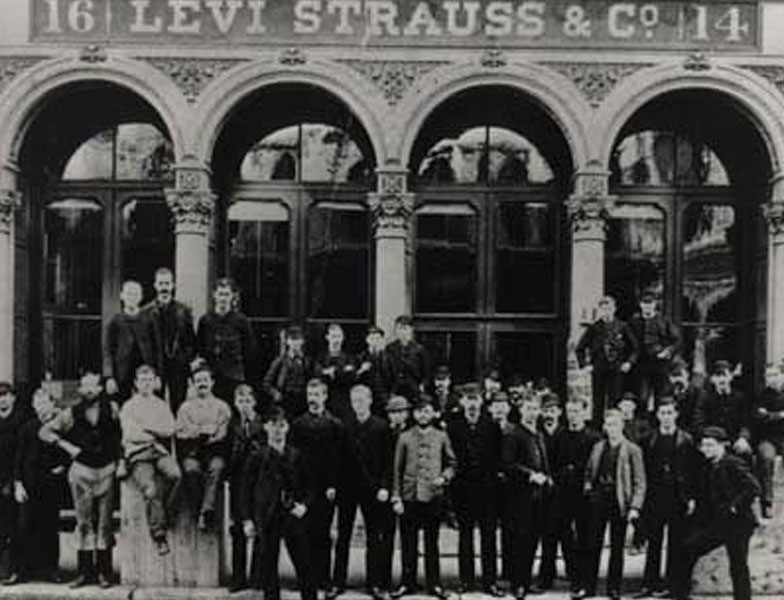
Rather than arriving with a roll of canvas under his arm, Strauss arrived carrying letters of introduction addressed to prominent members of San Francisco’s growing business community that allowed him to establish a successful dry goods wholesaling business with customers up and down the western coast and in the bordering states. The San Francisco miners weren’t Levi’s customers. Rather, it was the retailers and tailors who either sold finished goods to customers or used the raw materials like denim and duck cloth that Strauss supplied to make workwear. Strauss may have sold a wide range of workwear (including denim trousers), but he was not a manufacturer—at least not yet.
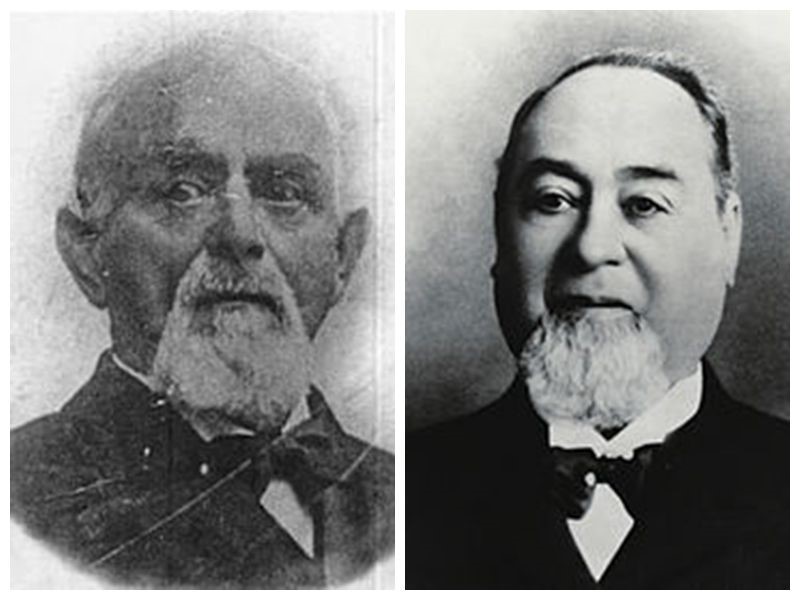
**Jacob Davis (left) and Levi Strauss (right)** In 1873, Strauss received a letter from Jacob Davis, a Reno tailor who had been purchasing bolts of cloth from Levi Strauss. Enclosed with the letter were two pairs of waist overalls that forever changed the fortunes of Strauss and his soon-to-be-partner Davis. Despite his atrocious spelling, Davis’s letter made it clear how his pants were unlike anything else on the market: “The secratt of them Pants is the Rivits that I put in those Pockets and I found the demand so large that I cannot make them fast enough […[ My nabors are getting yealouse of these successs and unless I secure it by Patent Papers it will soon become a general thing everybody will make them up and there will be no money in it.” The invention had been something of a lucky accident. The wife of a woodcutter had come to Davis asking him to make a pair large enough to fit around her husband’s prodigious waist. She also asked him to do something to make the pants a little more durable—her husband’s previous pairs had become unusable when the stitched-on pockets had torn. While assembling the pants, there were a few rivets on the tailor’s workbench. He had used these to attach straps to saddle blankets, so he thought they might do the trick. He used them to reinforce the pockets and the crotch of the pants and sent them on to the customer.
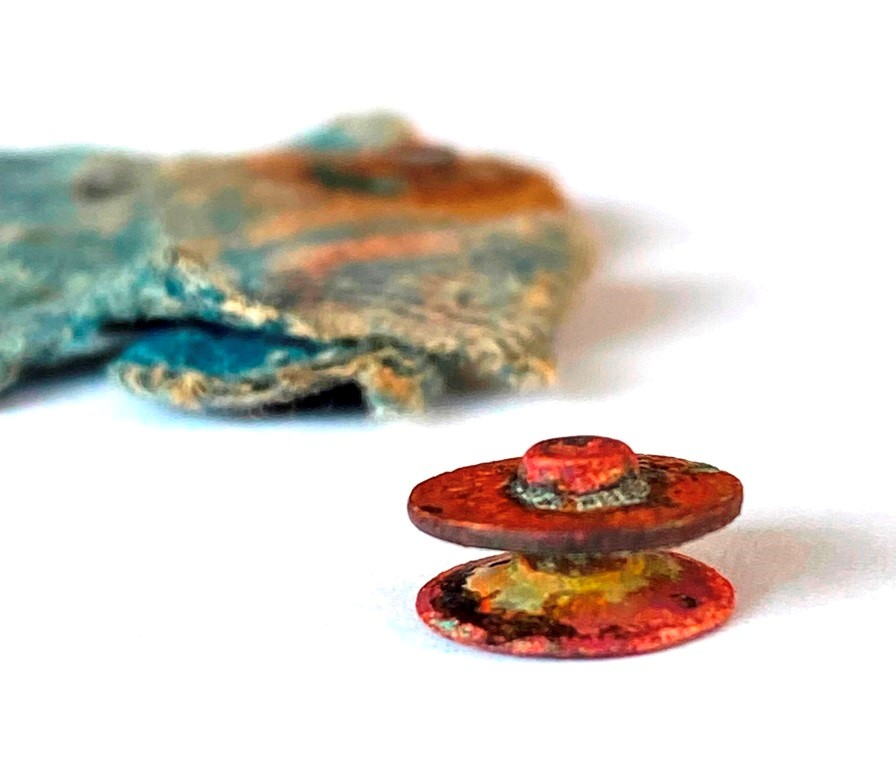
**Picture from Long John Denim Blog** Within a matter of months, he was receiving a steady stream of orders for his rivet-enforced pants. At this point, he realized that there was money in the idea. He reached out to Strauss, who immediately saw the potential—so much potential that he relocated Davis to San Francisco to oversee production of the overalls. It was the combination of Levi Strauss’s undeniable business savvy and the riveted overalls themselves that turned Levi Strauss from a prosperous dry goods merchant into a name forever associated with well-made workwear. The waist overalls were considerably stronger than their competitors’ products, and thanks to the patent, Levi Strauss was able to defend his unrivalled position as the king of workwear until the patent expired in the early 1890s.
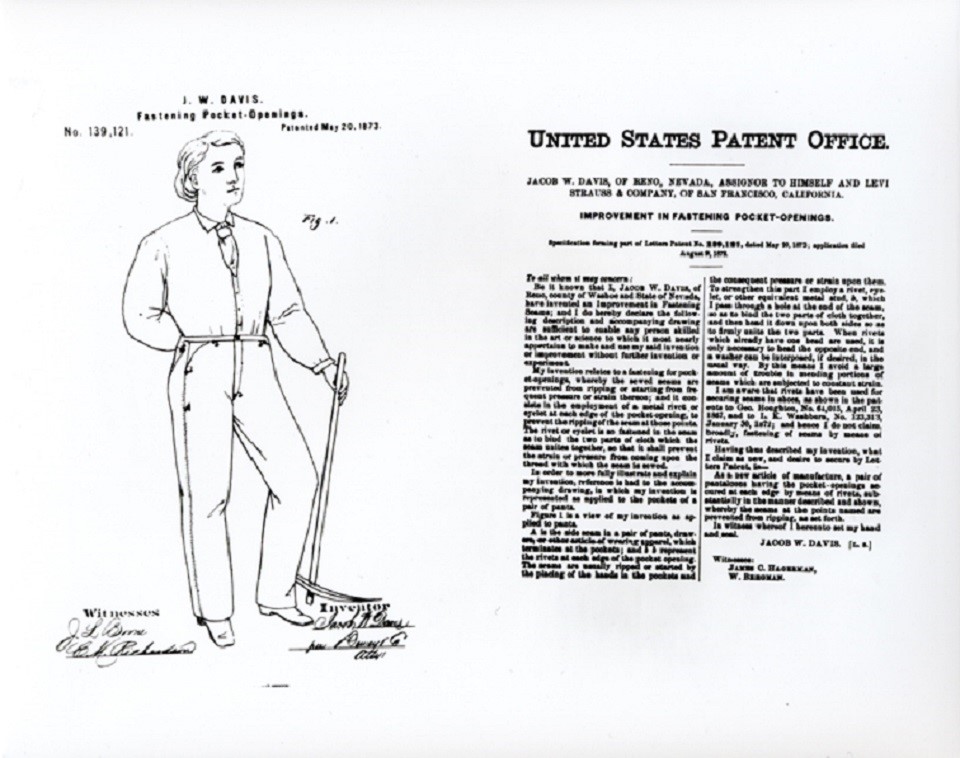
Remove either Levi Strauss or Jacob Davis and his humble rivet from the equation and the results would have been very different. Levi Strauss would have been a prosperous dry goods merchant, perhaps well known in his community, but it is unlikely he would be credited—as he is today—with giving America its defining garment. At the same time, without Strauss’s ability to manufacture Davis’s overalls in large quantities and market them as well as he did, Davis’s riveted denim trousers might never have spread from coast to coast. It is easy to see why the author of the Time article spun (or twisted) the Levi’s origin story in the way he did. It made the hero of the story Levi Strauss himself, excluding Jacob Davis and his rivet from the frame. While Davis’s contributions to the success of the two horse brand were immense, it was his copper fastener that did much of the heavy lifting. With the addition of rivets, the familiar product (denim overalls) was made shiny and new. Thanks to the small discs of copper, the product’s quality and durability were visible to the naked eye, and customers learned to trust the Levi’s Strauss brand because it was the only ones with the patented rivets. When the patent for the rivet-reinforced waist overalls expired, workwear brands were quick to follow Strauss’s lead and add rivets to their products, but by then, the Levi Strauss brand meant something. The rivet had done more than simply fasten together denim; it had also fastened customers to the brand. Thanks to the humble rivet, the bond was unbreakable. **This article draws on the research of Levi Strauss historian Lynn Downey. If you want to learn more, her book, Levi Strauss: The Man Who Gave Blue Jeans to the World, tells the complete story**
“Pantolonların sırrı Rivetler”: Levi Strauss Hikayesinin Gerçek Kahramanı
Efsanelerden bahsederken, Levi Strauss'un San Francisco'ya gelişini ve hemen ardından onun imza ürünü haline gelecek olan ürünü yaratışını anlatan hikâyeden bahsetmemek olmaz. Şubat 1950 tarihli bir Time makalesi, hikâyeyi şu şekilde anlatıyor: "20 yaşındaki Levi Strauss, 1850'de altın sahalarında servet aramak için Manhattan'dan Horn Burnu çevresinden San Francisco'ya yelken açtığında, yanında bir rulo kanvas taşıyordu. Madenci avansına yetecek parayı bulabilmek için onu bir çadır imalatçısına satmayı planlıyordu. Ancak karaya çıktığında, dost canlısı bir madencinin şikâyeti ona daha iyi bir fikir verdi. Madenci, "Pantolonlar kazı yaparken bir işe yaramıyor," dedi madenci. “Şöyle uzun süre dayanacak bir pantolon bulamıyorum.” Hikâyenin bu versiyonunda, bir maden arayıcı olma hayalinin peşinde koşan genç Levi Strauss aniden yön değiştirir ve o anda giyim işine girmeye karar verir. Bir terzinin yardımıyla, muhtemelen kendine çadır yapmak için kullanacağı malzeme, dayanıklı bir iş pantolonunun ana malzemesi haline geldi. Bu pantolonların San Francisco'nun güçlü, çalışkan madencileri arasında yayılması uzun sürmez; hikâyenin geri kalan kısmı da hepimizin malumu. Ne kadar ilham verici bir hikâye değil mi? Ancak, aslında gerçek bu değil. Muhtemelen markanın reklam departmanı tarafından uydurulmuş bir hikâye. Genç Levi Strauss kuşkusuz yetenekli bir girişimci olsa da, oralara zengin olma umuduyla gelmedi. Asıl niyeti, var olan aile şirketinin Batı şubesini açmaktı. J. Strauss & Brother ('Brother', yani erkek kardeş Louis, Levi değil) büyük bir New York'lu manifaturacılık firmasıydı. Levi Strauss, 1848'de Bavyera'dan New York'a erkek kardeşinin firmasında çalışmak için gelmişti. Geldikten beş yıl sonra, 23 yaşındaki Levi Strauss'un firmanın ürünlerini San Francisco'da pazarlaması için batıya gitmesine karar verildi.

Strauss, kolunun altında bir tuval rulosu yerine, elinde San Francisco'nun büyüyen iş dünyasının önde gelen üyelerine hitaben yazılmış tavsiye mektuplarla geldi ve bu mektuplar, Strauss'un ABD'nin hem Batı kıyısındaki eyaletlerinde hem de komşu eyaletlerde geniş bir müşteri kitlesine sahip olan başarılı bir manifaturacılık firması kurmasını sağladı. San Francisco madencileri Levi's markasının aklındaki müşteri kitlesi değildi. Daha çok, müşterilere hazır ürünler satan ya da Strauss'un tedarik ettiği denim ve tuval gibi hammaddeleri iş giysisi üretmek için kullanan perakendeciler ve terzilerdi. Birçok iş kıyafeti (denim pantolonlar dahil) satmış olsa da Strauss, başta bu ürünlerin imalatçısı değildi.
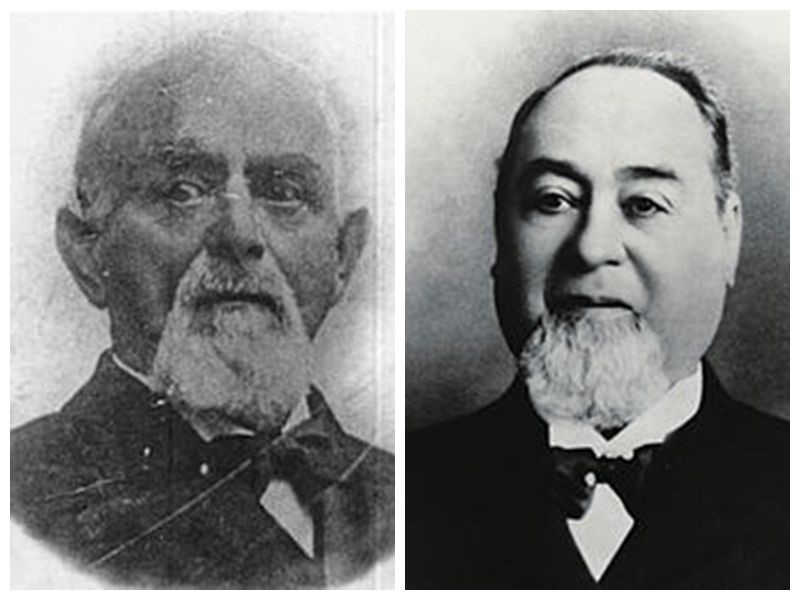
**Jacob Davis (solda) ve Levi Strauss (sağda)** 1873'te Strauss, Levi Strauss'tan bolca kumaş satın alan Reno'lu terzi Jacob Davis'ten bir mektup aldı. Mektup birlikte, Strauss ve yakında ortağı olacak Davis'in kaderini sonsuza dek değiştirecek olan iki adet tulum gönderilmişti. Korkunç yazım hatalarına rağmen, Davis'in mektubu, ürettiği pantolonların eşsiz olduğunu açıkça ortaya koyuyordu: "Pantolonların sırrı o Ceplere koyduğum rivetler ve talep o kadar büyük ki siparişleri yetiştiremiyorum [...Komşularım başarımı şimdiden beni kıskanıyor ve patentle güvence altına almazsam, yakında herkesin bildiği bir şey haline gelecek ve bu işten para kazanamayacağız.” Ürünün ortaya çıkışı, aslında güzel bir tesadüf sonucu oldu. Bir oduncunun karısı Davis'e gelmiş ve ondan kocasının devasa beline uyacak büyüklükte bir pantolon dikmesini istemişti. Ayrıca bu pantolonun nispeten daha dayanıklı olmasını rica etti - kocasının önceki pantolonları, dikişli cepler yırtıldığında kullanılamaz hale gelmişti. Pantolonu yaparken terzinin tezgahında birkaç rivet vardı. Bunları eyer örtüsüne kayış yerleştirmek için kullanmıştı, bu yüzden işe yarayabileceklerini düşündü. Bunları kullanarak pantolonun ceplerini ve ağını güçlendirdi ve müşteriye gönderdi.
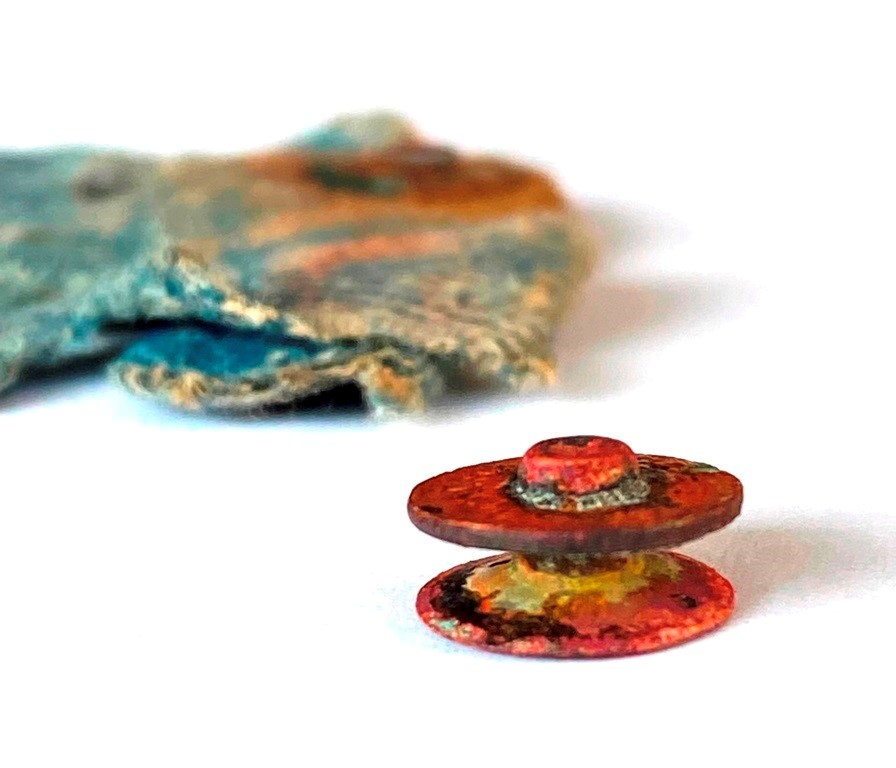
**Long John Denim Blog'dan bir resim** Birkaç ay içinde, rivetli pantolonları için gelen sipariş sayısı ciddi şekilde arttı. O noktada, bu işte para olduğunu anladı. İşteki potansiyeli hemen gören Strauss'a ulaştı - o kadar büyük bir potansiyel ki, tulumların üretim sürecini yönetmesi için Davis'i San Francisco'ya getirdi. Levi Strauss'a bir manifaturacı olarak değil kaliteli iş kıyafetleri üreticisi olarak tanınırlık kazandıran ve sonsuza dek bu şekilde hatırlanmasını sağlayacak şey, Levi Strauss'un yadsınamaz ticari zekasının ve rivetli tulumların bir araya gelişiydi. Tulumlar rakiplerinin ürünlerinden çok daha güçlüydü ve patent sayesinde Levi Strauss, 1890'ların başında patent süresi dolana kadar iş kıyafetlerinin kralı olarak rakipsiz konumunu koruyabildi.
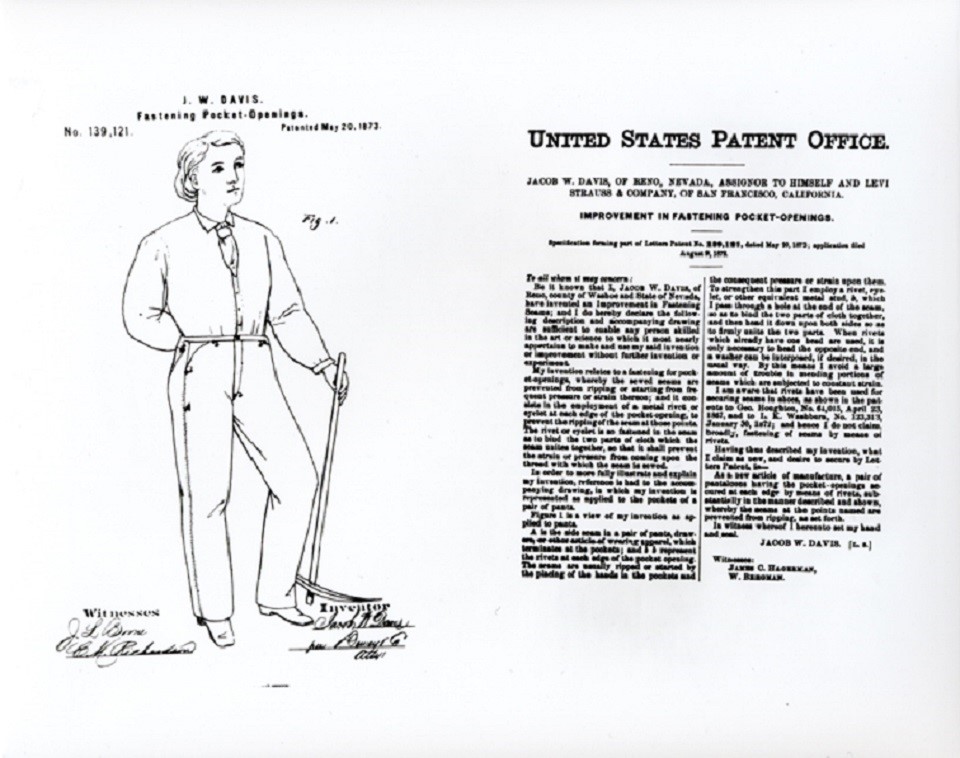
Levi Strauss veya Jacob Davis ve onun rivetleri olmasaydı, tarih akışı çok farklı bir şekilde seyrederdi. Levi Strauss, belki de kendi çevresinde iyi tanınan, zengin bir manifaturacı olarak hayatına devam ederdi ancak Amerika'ya, onu tanımlayan kıyafeti sunan kişi olarak anılması pek mümkün olmazdı. Aynı zamanda, Strauss'un Davis'in tulumlarını bol miktarlarda üretme ve pazarlama yeteneği olmasaydı, Davis'in rivetli denim pantolonları asla ülkenin dört bir yanına ulaşmayabilirdi. Time makalesinin yazarının neden Levi'nin başlangıç hikayesini bu şekilde eğip büktüğünü (veya çarpıttığını) anlamak kolay. Jacob Davis ve rivetini resmin dışında tutarak, Levi Strauss'u hikâyenin asıl kahramanı yaptı. Davis'in iki atlı markanın başarısına katkıları çok büyük olsa da, asıl işi yapan bakır raptiyelerdi. Rivetlerin eklenmesiyle tanıdık bir ürün (denim tulumlar) yepyeni bir şekle büründü. Küçük bakır diskler sayesinde ürünün kalitesi ve dayanıklılığı çıplak gözle görülebiliyordu ve müşteriler, patentli rivetlere sahip tek marka olduğu için Levi's Strauss markasına yöneldiler. Rivet takviyeli bel tulumlarının patent süresi sona erdiğinde, diğer iş kıyafeti markaları Strauss'un yaptıklarını kopyaladılar ancak o zamana kadar Levi Strauss markası gönüllerde taht kurmuştu bile. Rivet, sadece denim parçalarını birbirine değil, aynı zamanda müşterileri de markaya da bağlamıştı. Basit bir rivet sayesinde kurulan bağı yok etmek artık mümkün değildi. **Bu makale, Levi Strauss tarihçisi Lynn Downey'nin araştırmasına dayanmaktadır. Daha fazlasını öğrenmek isterseniz, Levi Strauss: Dünyaya Blue Jean'i Veren Adam (The Man Who Gave Blue Jeans to the World) adlı kitapta hikâyeyi bütün ayrıntılarıyla bulabilirsiniz**
To view full content and a better mobile experience, try



